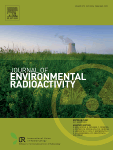
Publication date: November 2017
Source:Journal of Environmental Radioactivity, Volumes 178–179
Author(s): Shingo Kobayashi, Takayuki Shinomiya, Takahiro Ishikawa, Hitoshi Imaseki, Kazuki Iwaoka, Hisashi Kitamura, Satoshi Kodaira, Keisuke Kobayashi, Masakazu Oikawa, Norihiro Miyaushiro, Yoshio Takashima, Yukio Uchihori
A low
134Cs/
137Cs ratio anomaly in the north-northwest (NNW) direction from the Fukushima Dai-ichi Nuclear Power Station (FDNPS) is identified by a new analysis of the
134Cs/
137Cs ratio dataset which we had obtained in 2011–2015 by a series of car-borne surveys that employed a germanium gamma-ray spectrometer. We found that the
134Cs/
137Cs ratio is slightly lower (0.95, decay-corrected to March 11, 2011) in an area with a length of about 15 km and a width of about 3 km in the NNW direction from the FDNPS than in other directions from the station. Furthermore, the area of this lower
134Cs/
137Cs ratio anomaly corresponds to a narrow contamination band that runs NNW from the FDNPS and it is nearly parallel with the major and heaviest contamination band in the west-northwest. The plume trace with a low
134Cs/
137Cs ratio previously found by other researchers within the 3-km radius of the FDNPS is in a part of the area with the lower
134Cs/
137Cs ratio anomaly that we found. Our result suggests that this lower
134Cs/
137Cs ratio anomaly is the area which was contaminated before March 13, 2011 (UTC) in association with the hydrogen explosion of Unit 1 on March 12, 2011 at 06:36 (UTC) and it was less influenced by later subsequent plumes.
from Radiology via xlomafota13 on Inoreader http://ift.tt/2fmjxMy
via
IFTTT